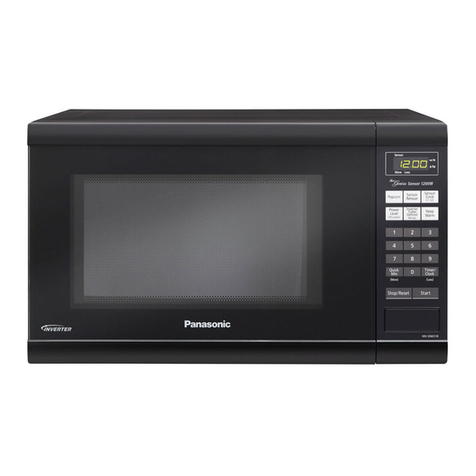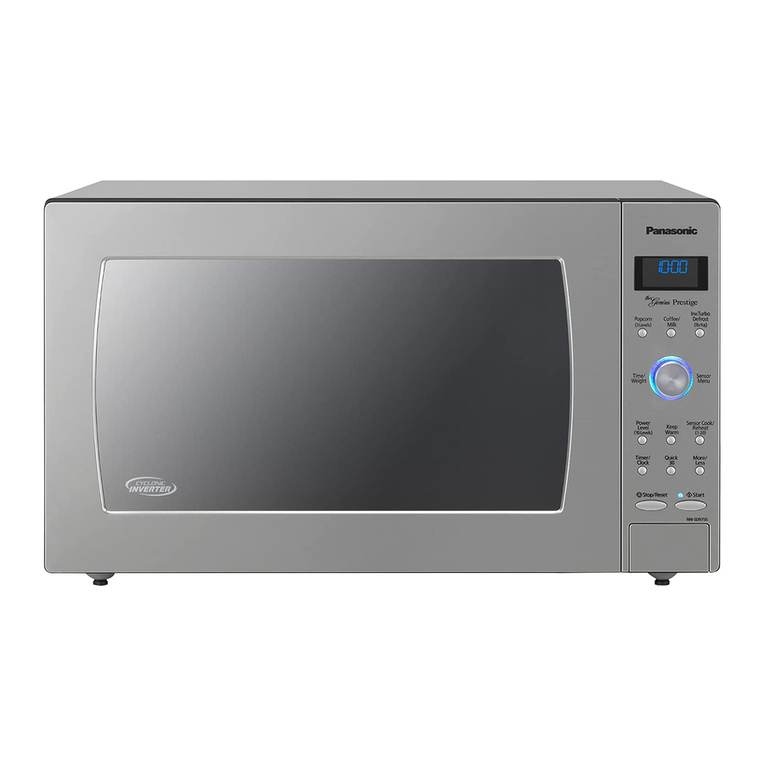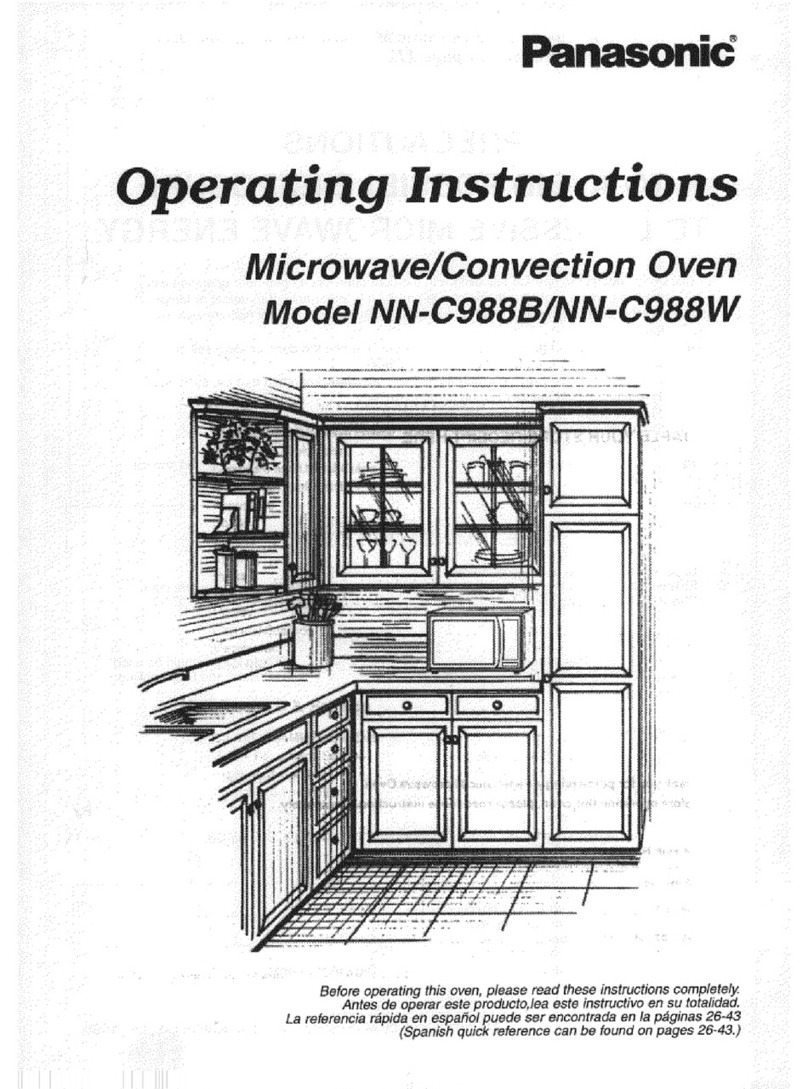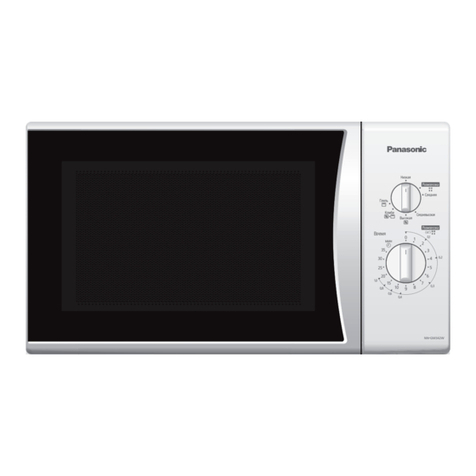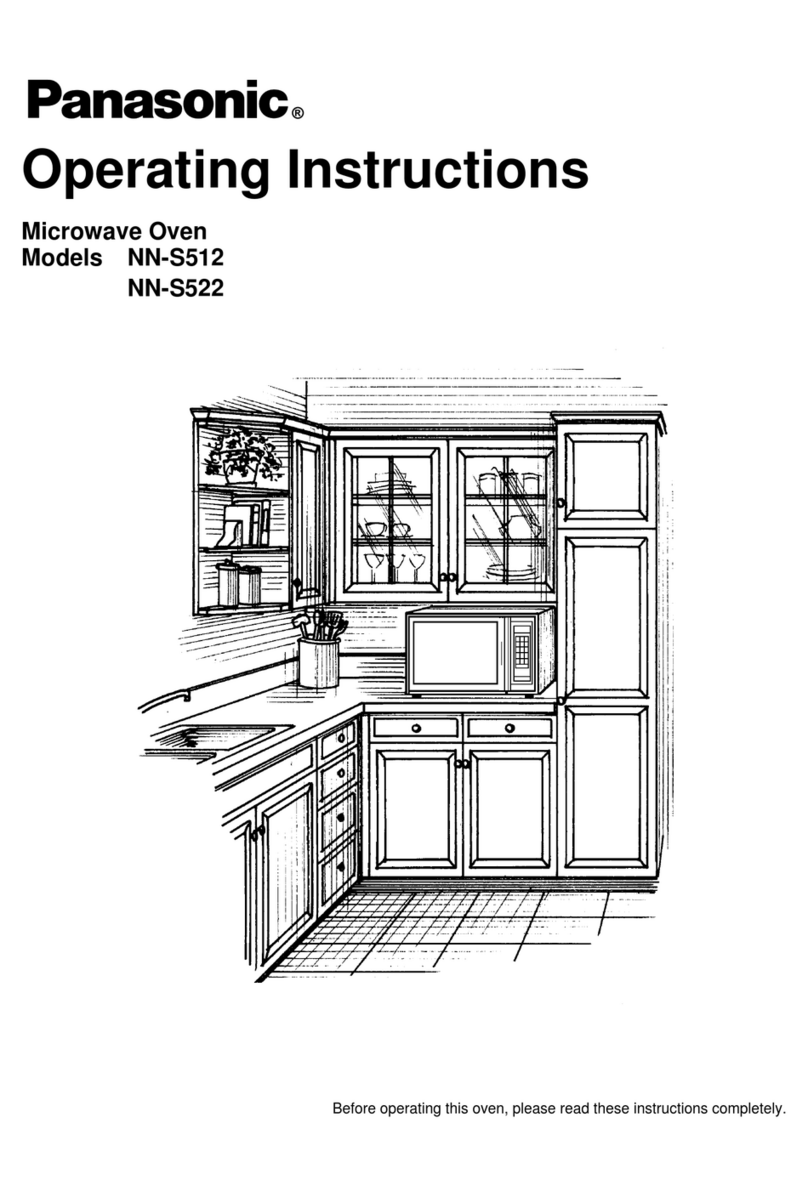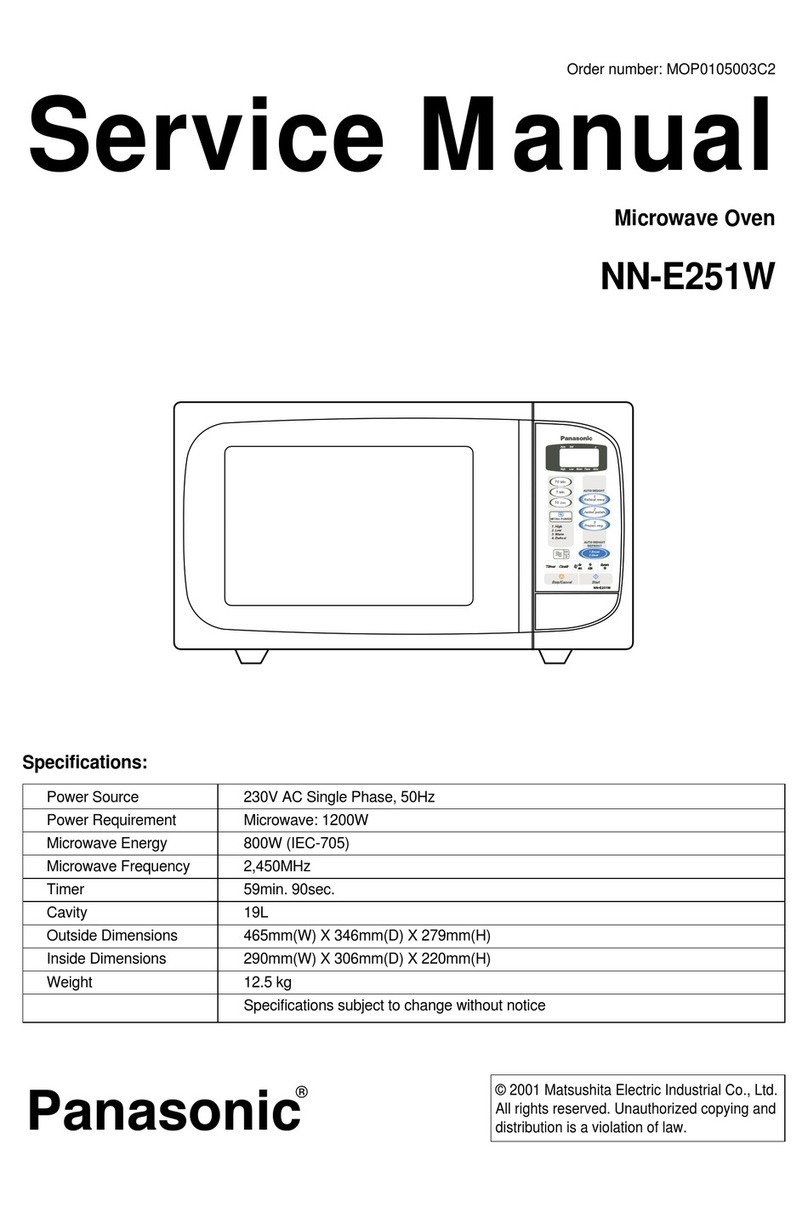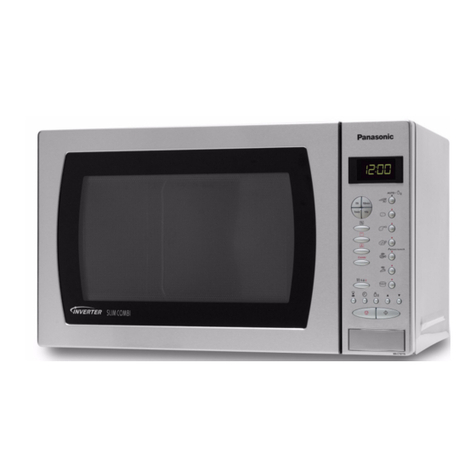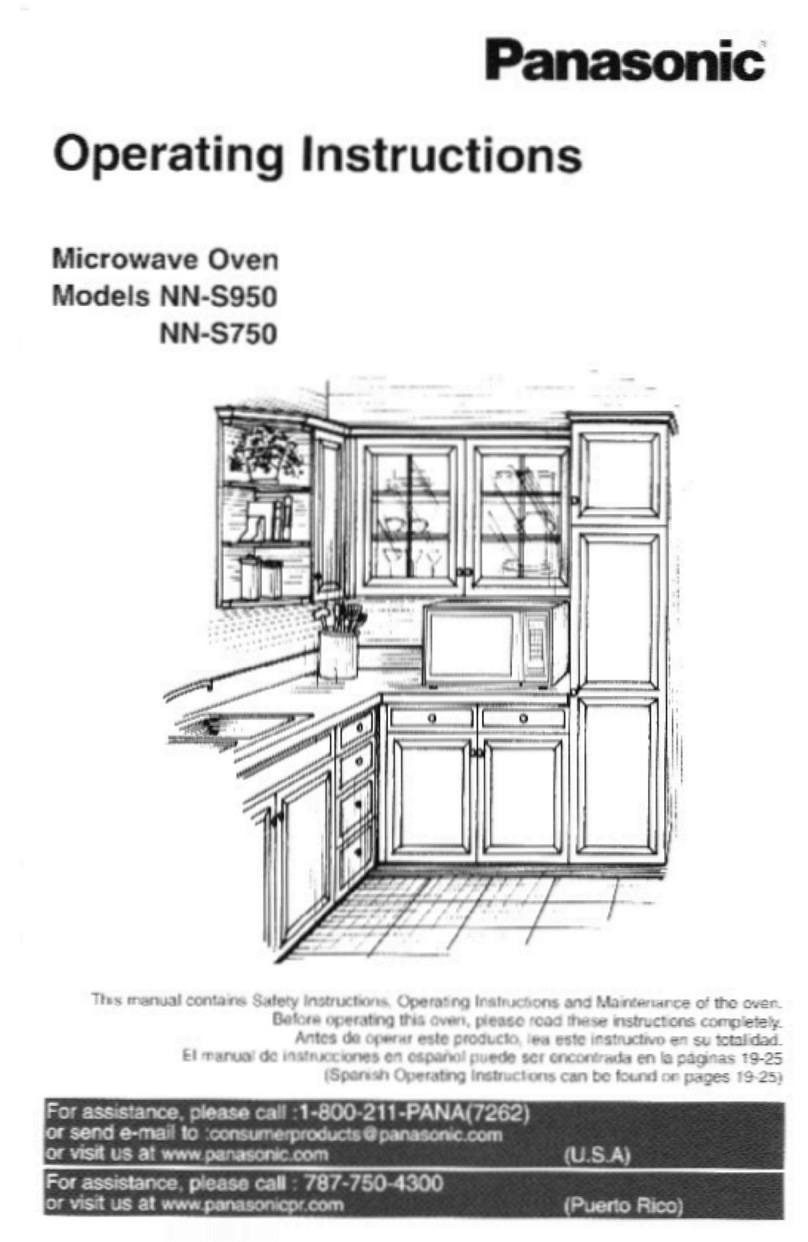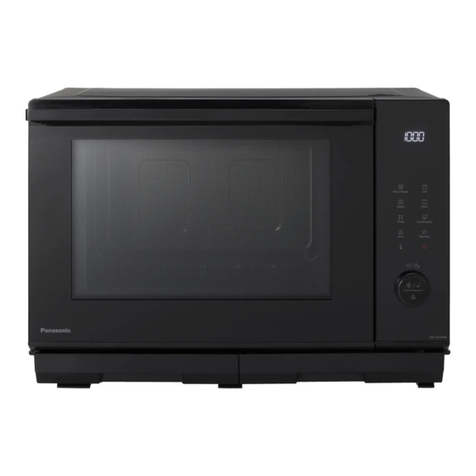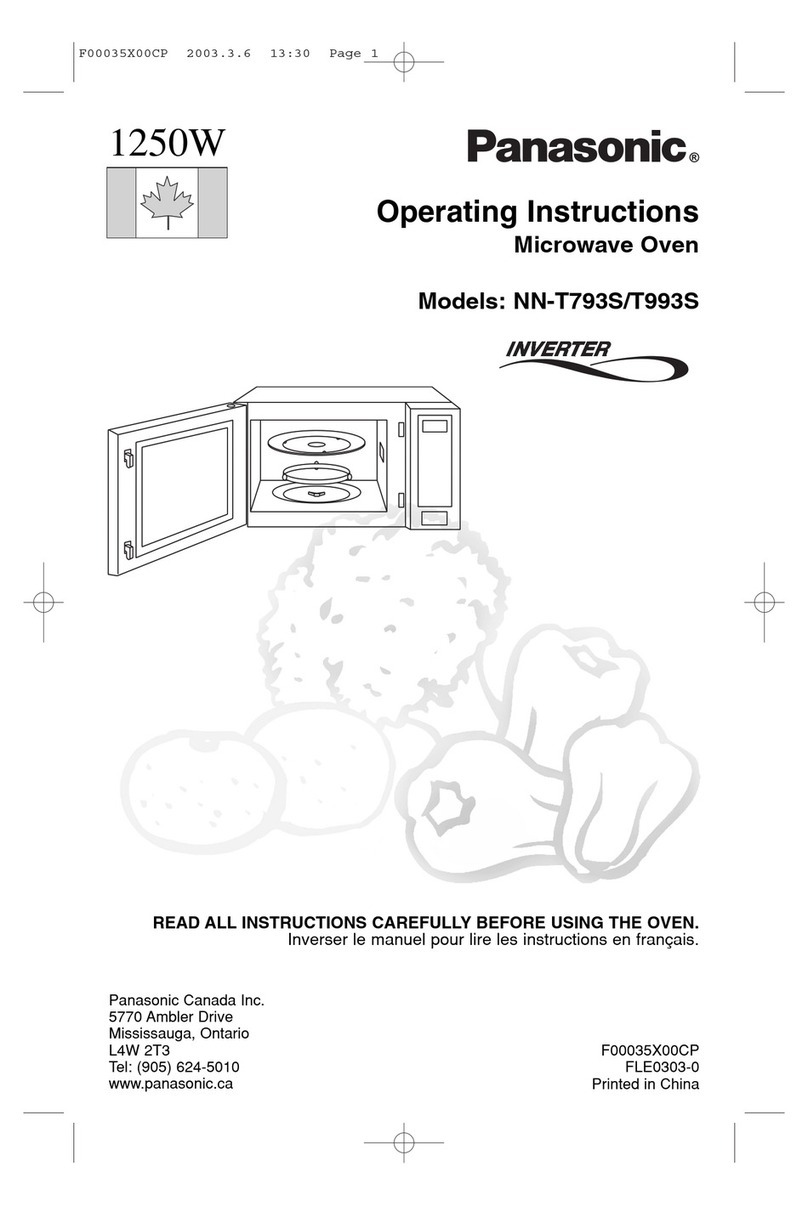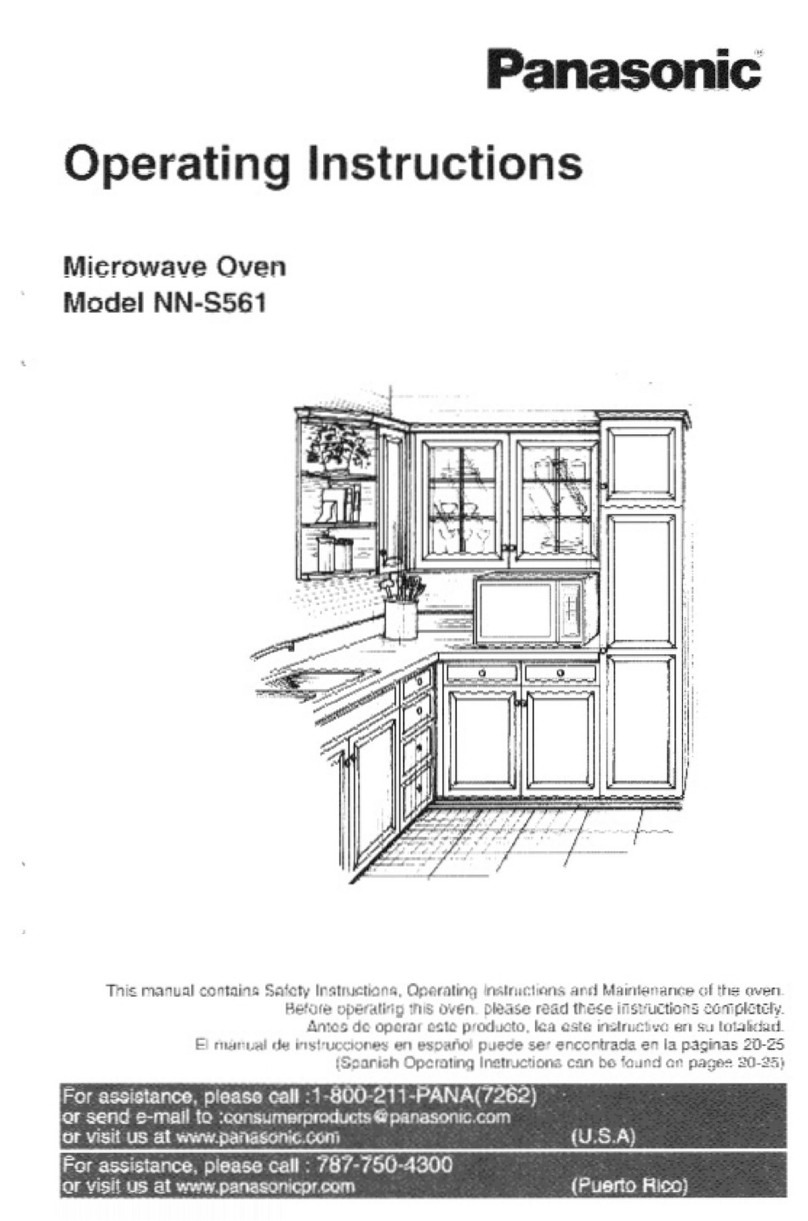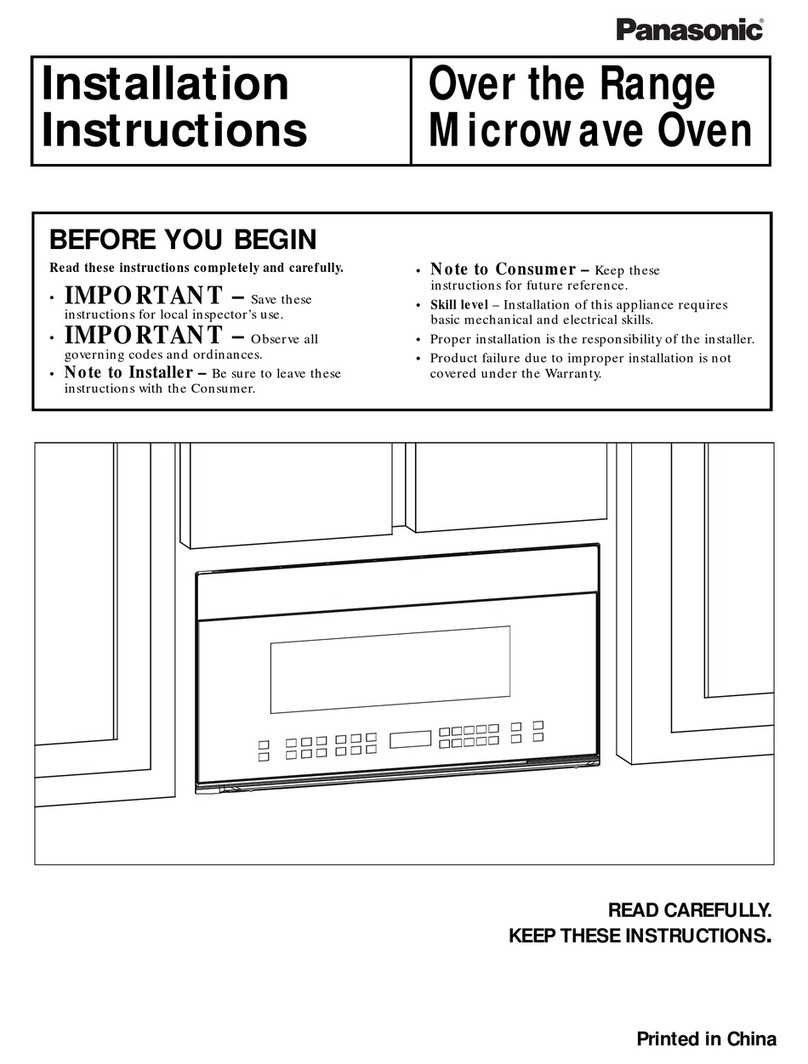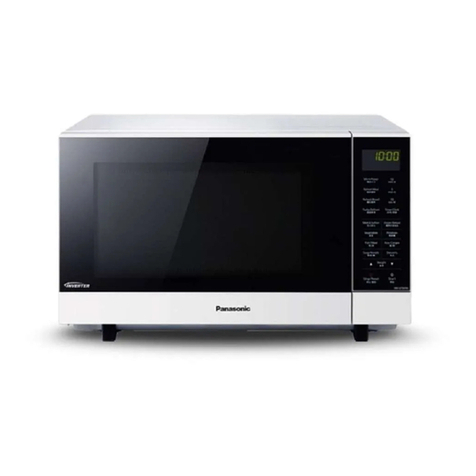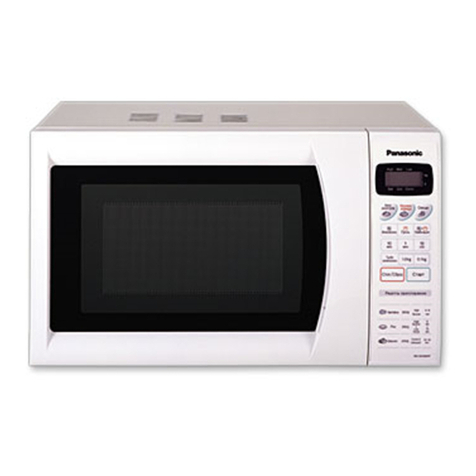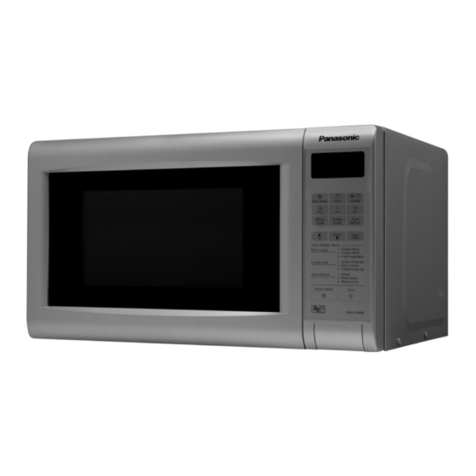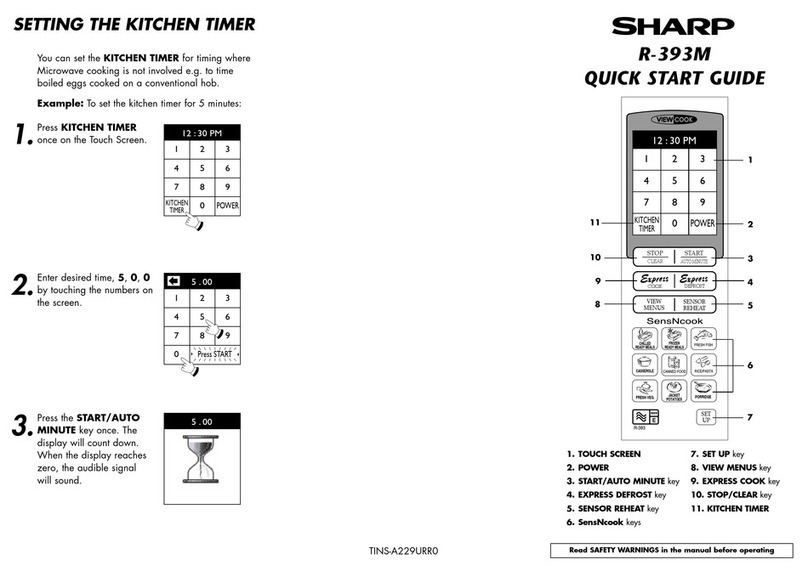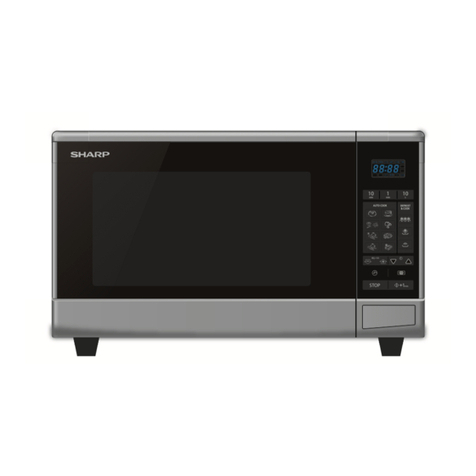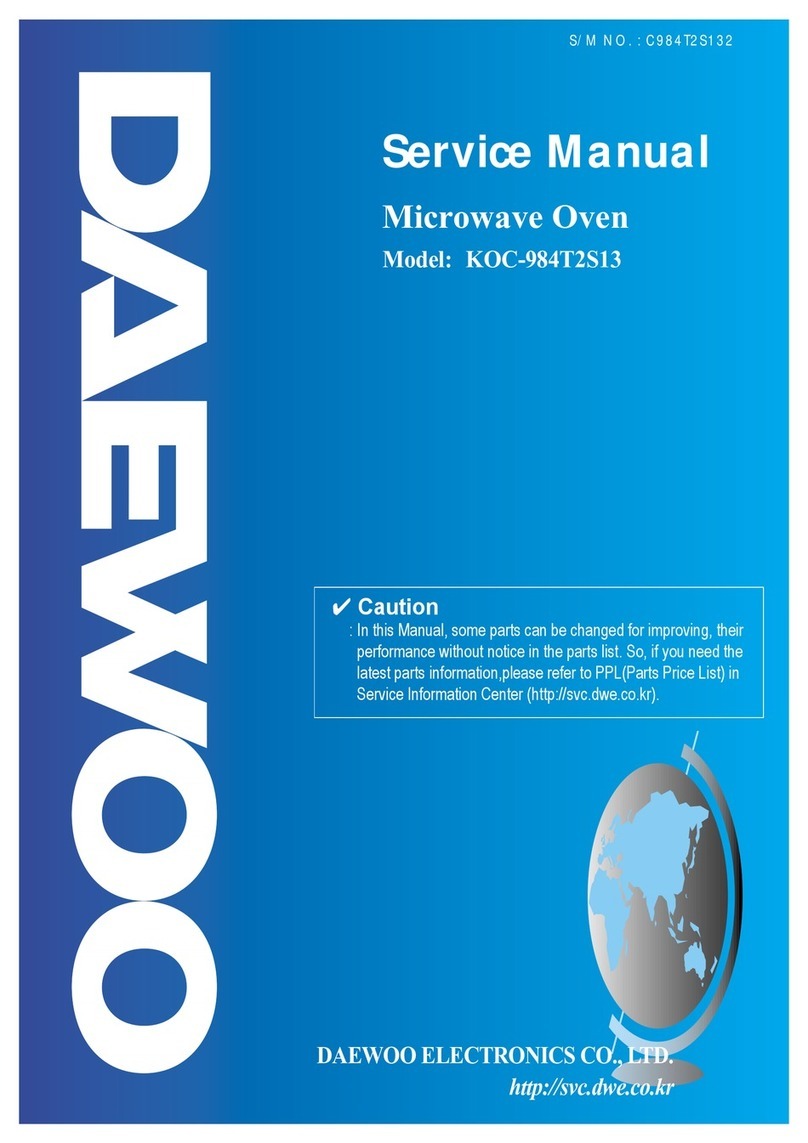
– 6 – – 7 –
Important Safety Instructions (continued)
WARNING
a) The door seals and door seal areas should be cleaned with a damp cloth. The appliance should be
inspected for damage to the door seals and door seal areas and if these areas are damaged the
appliance should not be operated until it has been repaired by a qualified service technician trained by
the manufacturer.
b) If the door or door seals are damaged, the oven must not be operated until it has been repaired by a
competent person.
c) It is dangerous for anyone other than a service technician trained by the manufacturer to perform repair
service.
d) It is hazardous for anyone other than a competent person to carry out any service or repair operation that
involves the removal of a cover which gives protection against exposure to microwave energy.
e) If the supply cord is damaged, it must be replaced by the manufacturer, its service agent or similarly
qualified persons in order to avoid a hazard.
f) Before use, the user should check that whether the utensils are suitable for use in microwave ovens.
g) Liquids or other foods must not be heated in sealed containers since they are liable to explode, at the
same time it should avoid the boiling liquids splash.
h) Only allow children to use the oven without supervision when adequate instructions have been given so
that the child is able to use the oven in a safe way and understands the hazards of improper use.
i) When the appliance is operated in the Grill, Oven, Steam and Combination modes, children should
only use the oven under adult supervision due to the temperatures generated.
Installation and General Instructions
Installation and General Instructions (continued)
General Use
1. In order to maintain high quality, do not operate
the oven when empty. The microwave energy will
reflect continuously throughout the oven if no food
or water is present to absorb energy. This can lead
to damage to the microwave oven including arcing
within the oven cavity.
2. If smoke is observed, tap Stop/Cancel and
leave door closed in order to stifle any flames.
Disconnect the power cord, and/or shut off power
at the fuse or circuit breaker panel.
3. The microwave oven is intended for heating food
and beverages. Drying of food or clothing and
heating of warming keys, slippers, sponges, damp
cloth and similar may lead to risk of injury, ignition
or fire.
4. Do not dry clothes, newspapers or other materials
in oven. They may catch on fire.
5. Do not use recycled paper products, unless the
paper product is labelled as safe for microwave
oven use. Recycled paper products may contain
impurities which may cause sparks and/or fires
when used.
6. Do not use newspapers or paper bags for cooking.
7. Do not hit or strike control panel. Damage to
controls may occur.
8. POT HOLDERS may be needed as heat from food
is transferred to the cooking container and from
the container to the oven. The oven can be very
hot after removing the cooking container from the
oven.
9. Do not store flammable materials next to, on top of,
or in the oven. It could be a fire hazard.
10. Do not cook food directly on the base of oven
unless indicated in recipes. (Food should be placed
in a suitable cooking utensil.)
11. DO NOT use this oven to heat chemicals or other
non-food products. DO NOT clean this oven with
any product that is labelled as containing corrosive
chemicals. The heating of corrosive chemicals
in this oven may cause microwave radiation
leaks.
12. When using the Combination with microwave
mode, never place any aluminum or metal
container directly on the Grill Tray.
13. Do not use the Grill Tray when cooking in the
Microwave mode only.
14. During cooking, some steam will condense inside
and/or on the oven door. This is normal and safe.
Steam will disappear after the oven is cool down.
15. Do not leave the microwave unattended while
reheating or cooking food in disposable containers
made of plastic, paper or other combustible
materials, as these types of containers can ignite if
overheated.
16. Metallic containers for food and beverages are not
allowed during microwave cooking.
17. Only use utensils that are suitable for use in
microwave ovens.
Placement of the Oven
This oven is intended for Counter-top use only. It is not
intended for built-in use or use inside a cupboard.
1. The oven must be placed on a flat, stable surface,
more than 85 cm above the floor. For correct
operation, the oven must have sufficient air flow,
i.e. 5 cm at one side, the other being open; 25
cm clear over the top; 10 cm at the rear. Do not
remove feet.
(a) Do not block air vents. If they are blocked
during operation, the oven may be overheated
and damaged. When using any cloth over the
oven, the air intake and exhaust should not be
blocked. Do not place a cloth on top of the unit
during Grill, Oven, Steam and Combination
cooking as the top of the oven gets very hot.
Also allow sufficient space on back and both
sides of the oven.
(b) Do not place oven near a hot or damp surface
such as a gas stove, electric range or sink etc.
(c) Do not operate oven when room humidity is too
high.
2. This oven was manufactured for household use
only.
Food
1. Do not use your oven for home canning or the
heating of any closed jar. Pressure will build up and
the jar may explode. In addition, the microwave
oven cannot maintain the food at the correct
canning temperature. Improperly canned food may
spoil and be dangerous to consume.
2. Do not attempt to deep fat fry in your microwave
oven.
3. Eggs in their shell and whole hard-boiled eggs
should not be heated in microwave ovens since
they may explode, even after microwave heating
has ended.
4. Potatoes, apples, egg yolks, chicken wings, whole
squash and sausages are examples of foods with
nonporous skins. This type of food must be pierced
before cooking, to prevent bursting.
5. When heating liquids, e.g. soup. sauces and
beverages in your microwave oven, overheating
the liquid beyond boiling point can occur without
evidence of bubbling. This could result in a sudden
boil over of the hot liquid. To prevent this possibility
the following steps should be taken:
(a) Avoid using straight-sided containers with
narrow necks.
(b) Do not overheat.
(c) Stir the liquid before placing the container in the
oven and again halfway through cooking time.
(d) After heating, allow to stand in the oven for
a short time, stirring again before carefully
removing the container.
(e) Microwave heating of beverages can result in
delayed eruptive boiling, therefore care must be
taken when handling the container.
(f) As a general rule, always cover wet foods,e.g.
soups, casseroles and plated meals.
6. DO NOT USE A CONVENTIONAL MEAT
THERMOMETER IN THE MICROWAVE OVEN.
To check the degree of cooking of roasts and
poultry use a MICROWAVE THERMOMETER.
Alternatively, a conventional meat thermometer
may be used after the food is removed from the
oven. If undercooked, return meat or poultry to
the oven and cook for a few more minutes at the
recommended power level. It is important to ensure
that meat and poultry are thoroughly cooked.
7. COOKING TIMES given in the Cooking Guide
section are APPROXIMATE. Factors that may
affect cooking time are preferred degree of
moisture content, starting temperature, altitude,
volume, size, shape of food and utensils used. As
you become familiar with the oven, you will be able
to adjust for these factors.
8. It is better to UNDERCOOK RATHER THAN
OVERCOOK foods. If food is undercooked, it can
always be returned to the oven for further cooking.
If food is overcooked, nothing can be done. Always
start with minimum cooking times recommended.
9. Extreme care should be taken when cooking
popcorn in a microwave oven. Cook for minimum
time as recommended by manufacturer. Use
the directions suitable for the wattage of your
microwave oven. NEVER leave oven unattended
when popping popcorn.
10. When heating food in plastic or paper containers,
keep an eye on the oven due to the possibility of
ignition.
11. The contents of feeding bottles and baby food jars
are to be stirred or shaken and the temperature
is to be checked before consumption, in order to
avoid burns.

